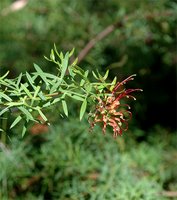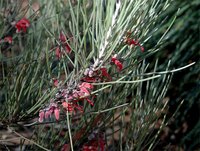 There are many "typical" forms of Grevillea flowers, and here I have just a few of them. These were taken at the Australian National Botanic Gardens, in Canberra, last week. I only had time for a quick trip around the place on an Electric Scooter, on a day out from hospital, so I just got a few photos. Sorry.
There are many "typical" forms of Grevillea flowers, and here I have just a few of them. These were taken at the Australian National Botanic Gardens, in Canberra, last week. I only had time for a quick trip around the place on an Electric Scooter, on a day out from hospital, so I just got a few photos. Sorry.
Even worse, I did not get to record the species names. Sorry, but I was being rushed.
Mostly these were flowers on shrubby Grevilleas, some quite small plants, others large shrubs. None of these were trees.
 This is a "Toothbrush" form of Grevillea flower, just opening.
This is a "Toothbrush" form of Grevillea flower, just opening.
These flowers are individual flowers, grouped together in a composite structure (an "inflorescence"). If you look at the prominently visible, individual curved protuberances, each one is the "style" (the female part) of a single flower. It has burst open, after being curled up inside the original curled part of the flower.
At a rough guess, there are probably 50 individual flowers in this head of flowers.
 This is a tightly formed "Cats Paw" form of Grevillea flower, from Grevillea alpina, I believe. All of these flowers are still unopened, and very tightly curled up.
This is a tightly formed "Cats Paw" form of Grevillea flower, from Grevillea alpina, I believe. All of these flowers are still unopened, and very tightly curled up.
It is at this point of time that the long styles (seen above) are tightly in contact with the male part of the flower (where the pollen is formed). When the flowers open, and the styles protrude, they come out dusted with pollen, which is then available to be collected by bees, or rubbed onto the heads of Honeyeaters, which come in search of the nectar which is found deep inside the flowers. At that freshly protruded stage (better seen in the Toothbrush" illustration above) the "style", while still dusted with pollen, is described as a "pollen presenter" - it is a female part of the flower, but it acts initially to present the pollen in a convenient location, to allow the pollen to be spread from flower to flower.
If you look closely (double click on the photo of the "Toothbrush" flower two photos up), look closely at the "styles" about 7 or 8 in from the right. They are very obviously "dusted in pollen". After several days, when the pollen is dispersed, or has dried up, the "style" then becomes mature, goes noticeably sticky on its end, and then acts in its true nature, as the female part of the flower, ready to collect the pollen from any passing bird or bee. This system of pollination is the same for the major members of the Proteaceae family, in Australia, the Waratahs, Hakeas, Banksias and Grevilleas. They are all closely related plants.
 At left is a less common flower (inflorescence) form (amongst Grevilleas), where the flowers are displayed along the stem. The flowers are all in pairs, which is typical of all Grevilleas.
At left is a less common flower (inflorescence) form (amongst Grevilleas), where the flowers are displayed along the stem. The flowers are all in pairs, which is typical of all Grevilleas.
So, no matter what the form of the flower cluster, be it "Toothbrush", or "Cats Paw" or whatever, if you look closely into the composite flower structure, you will find pairs of flowers in all Grevilleas.
Possibly the largest of the Grevillea flowers, on the Grevillea robusta, (the tree is known as the "Silky Oak") is a "toothbrush" form of flower, but it flowers in summer, so I could not photograph it now. It is typical of a group of northern Australian Grevilleas, many of which are trees, not shrubs, and which tend to have yellow flowers.
The role of colour in pollination:
There is a theory that flowers which are bird pollinated are advantaged if they are brightly coloured, especially red coloured. (Butterflies appear to like yellow flowers, such as Everlasting Daisies.)
One group of Grevilleas which I missed out on getting a photograph of is the tiny little creamy- white flowered flowered forms. They are apparently insect pollinated. They generally have a sweet honey scent, but with such tiny flowers that birds cannot possibly pollinate them. The general theory is that they are pollinated by moths, which fits with them mostly being coloured white or cream (to aid the night vision of moths).
Certainly being coloured red or yellow is an advantage to those which are bird pollinated. However, there are some which are dull green and nearly invisible to the human eye, and yet the birds find them perfectly well. So, some theories break down, if you investigate them closely enough.

No comments:
Post a Comment